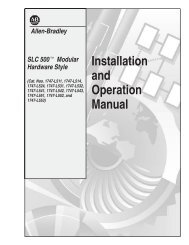1 Overview 2 Details of the Model Construction - Canada France ...
1 Overview 2 Details of the Model Construction - Canada France ...
1 Overview 2 Details of the Model Construction - Canada France ...
Create successful ePaper yourself
Turn your PDF publications into a flip-book with our unique Google optimized e-Paper software.
above which a transition between laminar flow over and around <strong>the</strong> terrain to turbulent flow would be<br />
obtained. A set <strong>of</strong> visualization tests were performed with <strong>the</strong> upwind terrain probe B6 set at various<br />
elevations above <strong>the</strong> model while varying <strong>the</strong> flow speed from 10 to 50 cm/s in increments <strong>of</strong> 10 cm/s.<br />
At <strong>the</strong> time <strong>the</strong> experiment was conducted we believed that we saw a transition in <strong>the</strong> flow pattern from<br />
a 10 cm/s to 20 cm/s free flow water speed in <strong>the</strong> tunnel. Namely, <strong>the</strong> clear formation <strong>of</strong> a vortex on<br />
<strong>the</strong> leading edge <strong>of</strong> <strong>the</strong> observatory building with a scaled height <strong>of</strong> 5-6 m. However, examination <strong>of</strong><br />
<strong>the</strong> video footage after <strong>the</strong> fact does not lend evidence for this. The video stills in Figure 13 with <strong>the</strong><br />
B6 probe set 50 mm above <strong>the</strong> model terrain indicate that <strong>the</strong> vortex is present and <strong>of</strong> similar size at all<br />
<strong>the</strong> flow speeds investigated (side view images). Fur<strong>the</strong>rmore, <strong>the</strong> pr<strong>of</strong>ile and extent <strong>of</strong> <strong>the</strong> wake<br />
around <strong>the</strong> building does not change in a noticeable way when looking at <strong>the</strong> top-down view.<br />
The flow speed <strong>of</strong> 30 cm/s was used for all but a few <strong>of</strong> <strong>the</strong> tests. This speed was selected partly on <strong>the</strong><br />
basis <strong>of</strong> remaining well above <strong>the</strong> velocity <strong>of</strong> <strong>the</strong> perceived transition between 10 and 20 cm/s. O<strong>the</strong>r<br />
factors that influenced this choice was that operation above 40 cm/s for extended periods <strong>of</strong> time was<br />
discouraged by <strong>the</strong> UWAL staff and that <strong>the</strong> flushing time (from some quick undocumented tests with<br />
<strong>the</strong> unvented dome) was found to be short enough to allow efficient progress <strong>of</strong> <strong>the</strong> experiments while<br />
being long enough to allow accurate measurement <strong>of</strong> <strong>the</strong> flushing time.<br />
Note that at 30 cm/s <strong>the</strong> Reynolds number Re associated with an ideal spherical obstruction <strong>of</strong> diameter<br />
L is;<br />
Re= ρ VL<br />
μ =999.7(kg /m3 )⋅0.3(m⋅s −1 )⋅0.2 (m)/1.307x10 −3 ( N⋅s⋅m −2 @10 o C )=4.6x10 4<br />
where ρ is <strong>the</strong> density and μ is dynamic viscosity <strong>of</strong> water at <strong>the</strong> test temperature (average <strong>of</strong> ~10 C<br />
over <strong>the</strong> testing period). The dynamic viscosity <strong>of</strong> air depends primarily on temperature; at 0 C it is<br />
1.35x10 -5 N s m -2 . The air density at 4200 m is 0.80 kg/m 3 and with 32 m diameter dome <strong>the</strong> wind<br />
speed to which <strong>the</strong> above model Reynold's number corresponds to in <strong>the</strong> real-world observatory is 2.4<br />
cm/s. For comparison, <strong>the</strong> median wind speed at <strong>the</strong> location <strong>of</strong> CFHT on <strong>the</strong> summit <strong>of</strong> Mauna Kea is<br />
15 knots (7.7 m/s); which is over 300 times greater than <strong>the</strong> scale speed obtained in our water tunnel<br />
experiment.<br />
8 Description <strong>of</strong> <strong>the</strong> tests performed<br />
8.1 Parameters investigated<br />
The basic parameters that could be varied in <strong>the</strong> tests were as follows (numbers in paren<strong>the</strong>ses indicate<br />
<strong>the</strong> possible number <strong>of</strong> free parameters involved with each item):<br />
1. Water flow speed (1): Except for some quick investigations, this was kept fixed as <strong>the</strong><br />
dynamics <strong>of</strong> <strong>the</strong> flow would not change significantly unless order <strong>of</strong> magnitude changes were<br />
made to <strong>the</strong> speed. The flow rate was set to 30 cm/s.<br />
2. Dome configuration (3): Unvented dome, dome with small vents, dome with large vents.<br />
3. Dye probe locations. This was narrowed down to a few configurations for <strong>the</strong> bulk <strong>of</strong> <strong>the</strong> tests.<br />
Inside <strong>the</strong> dome (2): Probe A1 alone, and probes A3 & A5 combined. This was used for<br />
determination <strong>of</strong> dome flushing times.<br />
Outside <strong>the</strong> dome (1-2): Probes B1-B5 fired <strong>of</strong>f in succession to view flow around and into <strong>the</strong><br />
dome (this was not done for all <strong>the</strong> dome types), and probes B6 and B7 fired <strong>of</strong>f in succession<br />
to view flow around <strong>the</strong> dome on <strong>the</strong> upwind side and <strong>the</strong> reverse flow on <strong>the</strong> downwind side.



![Documentation [PDF] - Canada France Hawaii Telescope ...](https://img.yumpu.com/26965302/1/190x245/documentation-pdf-canada-france-hawaii-telescope-.jpg?quality=85)








